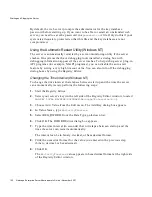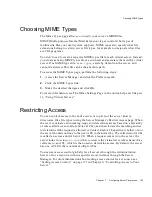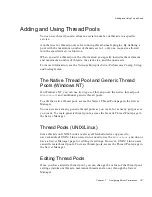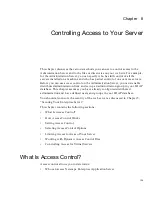
Choosing MIME Types
Chapter
7
Configuring Server Preferences
155
Choosing MIME Types
The Mime Types page allows you to edit your server’s MIME files.
MIME (Multi-purpose Internet Mail Extension) types control what types of
multimedia files your mail system supports. MIME types also specify what file
extensions belong to certain server file types, for example to designate what files
are CGI programs.
You don’t need to create a separate MIME types file for each virtual server. Instead,
you create as many MIME types files as you need and associate them with a virtual
server. One MIME types file,
mime.types
, exists by default on the server, and
cannot be deleted. This file can be the absolute path.
To access the MIME Types page, perform the following steps:
1.
Access the Server Manager and click the Preferences tab.
2.
Click the MIME Types link.
3.
Make the desired changes and click OK.
For more information, see The Mime Settings Page in the online help and Chapter
13, “Using Virtual Servers.”
Restricting Access
You can control access to the entire server or to parts of the server (that is,
directories, files, file types) using the Server Manager’s Restrict Access page. When
the server evaluates an incoming request, it determines access based on a hierarchy
of rules called access-control entries (ACEs), and then it uses the matching entries
to determine if the request is allowed or denied. Each ACE specifies whether or not
the server should continue to the next ACE in the hierarchy. The collection of ACEs
is called an access-control list (ACL). When a request comes in to the server, the
server looks in vsclass.
obj.conf
(where vsclass is the virtual server class name) for a
reference to an ACL, which is then used to determine access. By default, the server
has one ACL file that contains multiple ACLs.
You can set access control globally for all servers through the Administration
Server or for a resource within a specific server instance through the Server
Manager. For more information about setting access control for a resource, see
“Setting Access Control,” on page 171 in Chapter 8, “Controlling Access to Your
Server.”
Summary of Contents for NETSCAPE ENTREPRISE SERVER 6.0 - ADMINISTRATOR
Page 1: ...Administrator s Guide Netscape Enterprise Server Version6 0 November 2001...
Page 18: ...18 Netscape Enterprise Server Administrator s Guide November 2001...
Page 26: ...26 Netscape Enterprise Server Administrator s Guide November 2001...
Page 48: ...Migrating a Server 48 Netscape Enterprise Server Administrator s Guide November 2001...
Page 50: ...50 Netscape Enterprise Server Administrator s Guide November 2001...
Page 146: ...146 Netscape Enterprise Server Administrator s Guide November 2001...
Page 242: ...242 Netscape Enterprise Server Administrator s Guide November 2001...
Page 294: ...294 Netscape Enterprise Server Administrator s Guide November 2001...
Page 332: ...Deleting a Virtual Server 332 Netscape Enterprise Server Administrator s Guide November 2001...
Page 378: ...378 Netscape Enterprise Server Administrator s Guide November 2001...
Page 396: ...Responses 396 Netscape Enterprise Server Administrator s Guide November 2001...
Page 414: ...Posting to JSPs 414 Netscape Enterprise Server Administrator s Guide November 2001...
Page 432: ...Further Information 432 Netscape Enterprise Server Administrator s Guide November 2001...
Page 444: ...444 Netscape Enterprise Server Administrator s Guide November 2001...
















































